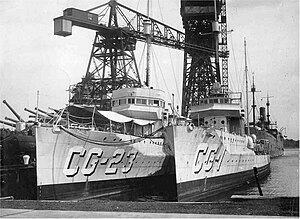Rum Patrol
| Rum Patrol | |
|---|---|

Rum Patrol ships USCGD Tucker and USCGD Cassin, circa 1930.
|
|
| Objective | Enforce prohibition in United States waters. |
| Date | 1920 – 1933 |
| Executed by |
|
The Rum Patrol was an operation of the United States Coast Guard to interdict liquor smuggling vessels, known as "rum runners" in order to enforce prohibition in American waters. On 18 December 1917, the 18th Amendment to the Constitution was submitted to the states by Congress. On 16 January 1919, the amendment was ratified and the Liquor Prohibition Amendment, which prohibited the manufacture, sale, transportation, importation, or exportation of intoxicating liquors, came into effect on 16 January 1920.
The establishment of prohibition gave rise to smuggling of illicit liquor into the United States and, to deal with this problem, twenty-five destroyers were transferred by the United States Navy to the Treasury Department for service with the Coast Guard. Some began to show signs of wear and tear after the often arduous pace of operations on the Rum Patrol and required replacement. Accordingly, five of the newer flush deck destroyers were transferred to the Treasury Department in 1930–1931.
It was thought that adapting these older vessels for Coast Guard service would be less costly than building new ships. In the end, however, the rehabilitation of the vessels became a saga in itself because of the exceedingly poor condition of many of these war-weary ships. In many instances, it took nearly a year to bring the vessels up to seaworthiness. Additionally, these were by far the largest and most sophisticated vessels ever operated by the service, and trained personnel were nearly nonexistent. As a result, Congress authorized hundreds of new enlistees. These inexperienced men generally made up the destroyer crews.
Some of the destroyers were pre-World War I 742-ton "flivvers", capable of over 25 kn (29 mph; 46 km/h) — an advantage in the rum-chasing business. They were, however, easily outmaneuvered by smaller vessels. The destroyers’ mission, therefore, was to picket the larger mother ships and prevent them from off-loading their cargo onto the smaller, speedier contact boats that ran the liquor into shore.
...
Wikipedia
